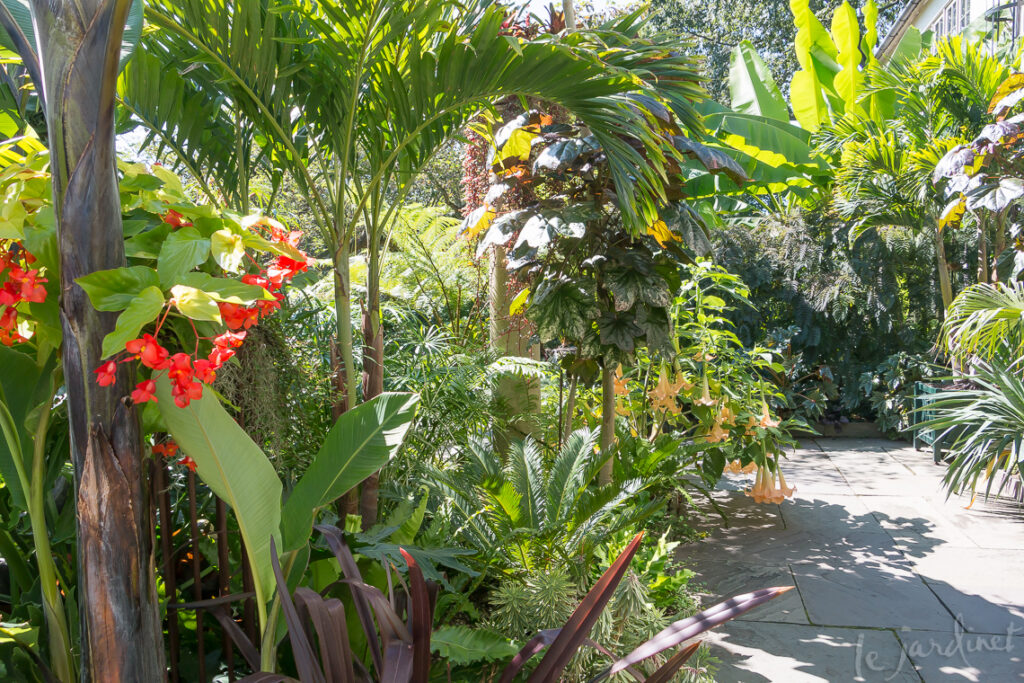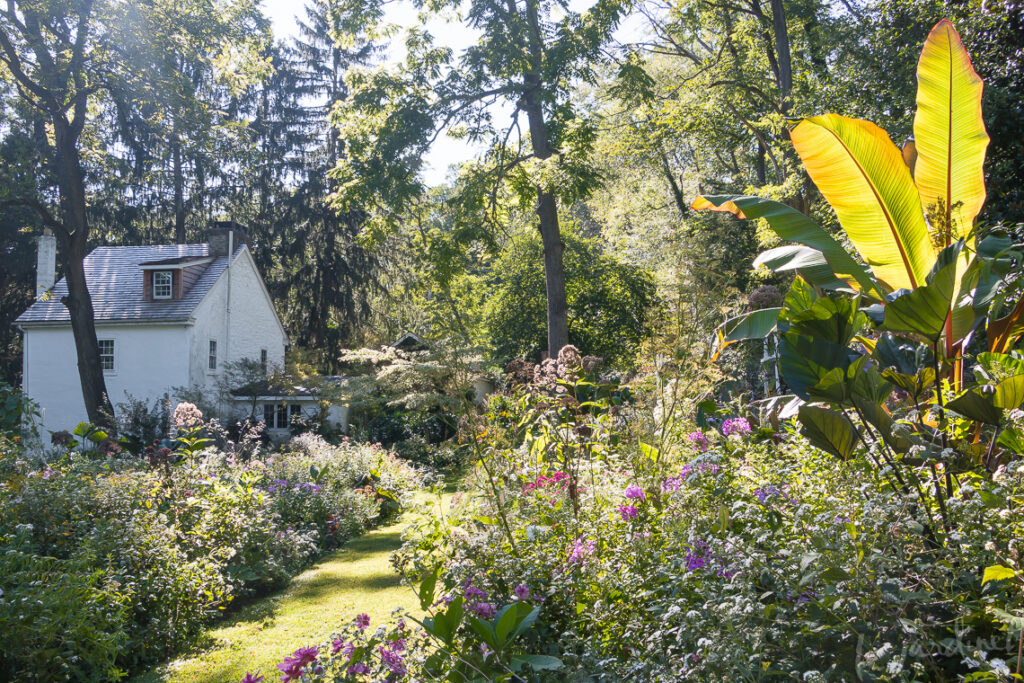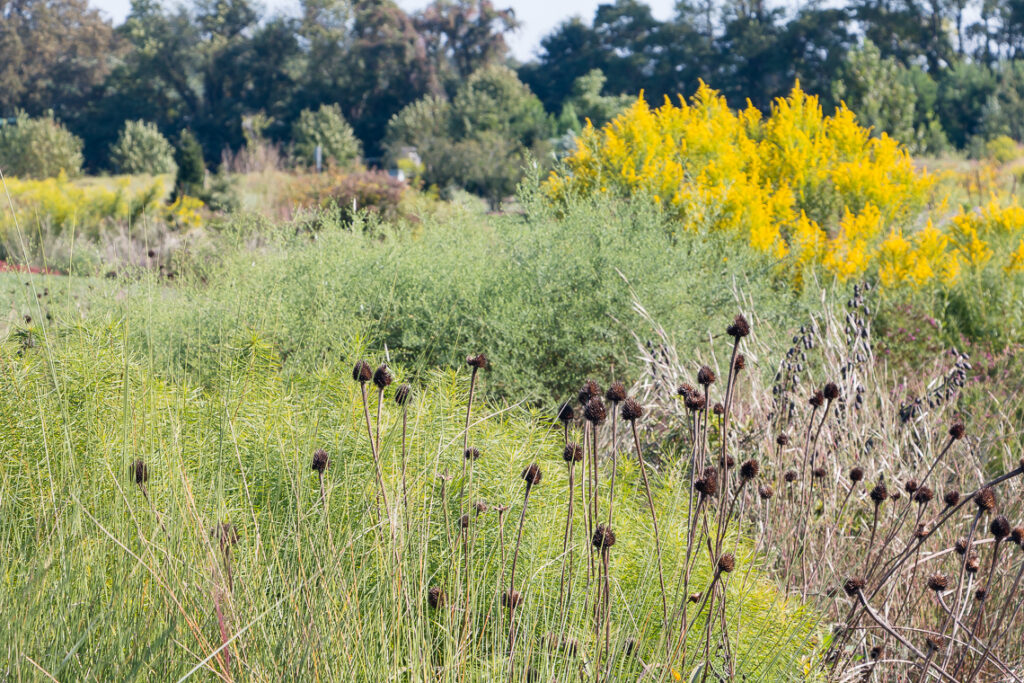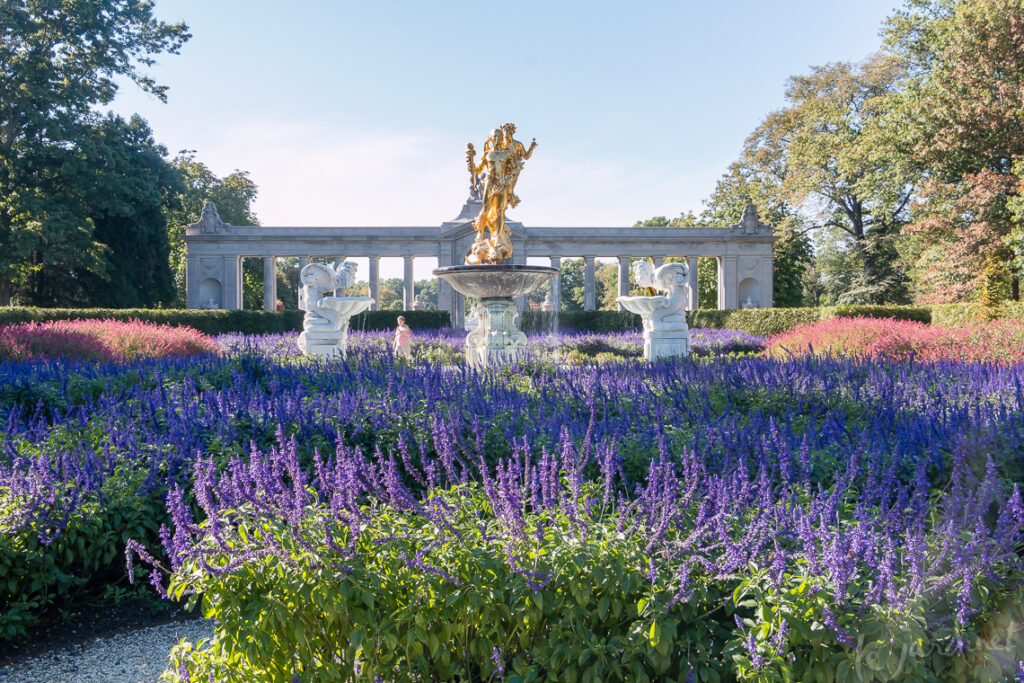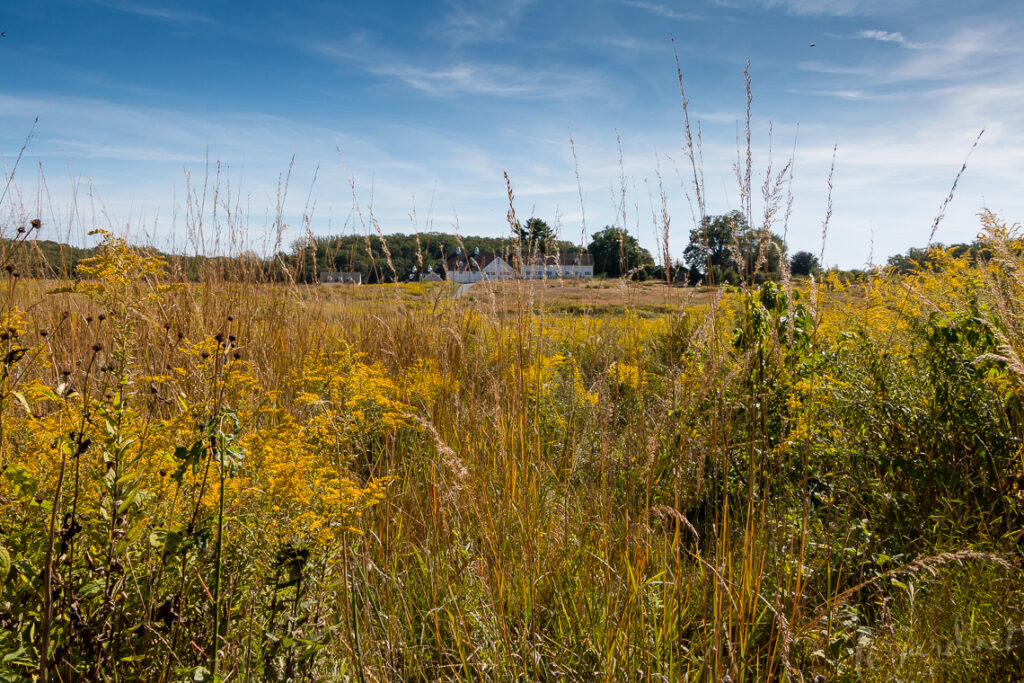5 Design Lessons from The Best of the Best

I've just returned from leading a tour to Gardens of the Delaware and Brandywine Valleys. Such a fabulous group of fun-loving guests!
Looking back over my many photographs I realized that in our excitement to visit outstanding gardens we can sometimes find it hard to see the 'take-home ideas', especially if our climate or plant palette is substantially different. As a designer I see inspiration everywhere, so thought I'd share just one design lesson, using a single photograph that I took from 5 of our top destinations this fall.
Creating Theater – Chanticleer
There's nothing subtle about the courtyard gardens at Chanticleer, designed by my talented friend and colleague Dan Benarcik. This is where he creates pure landscape theater. It is also the entry point into the gardens so intentionally sets the stage for guests to be wowed from their very first glimpse. Tropical foliage using drama queens such as banana and palms establish the upper canopy, beneath which are layered a lush abundance of begonias, ferns and fragrant brugmansia together with more humble perennials such as Euphorbia, selected for their leaf color and texture. The effect is that one feels very small within this exuberant jungle where light filters through to cast exotic shadows. Surely there are chimpanzees up there somewhere??
Try this:
Try taking your houseplants outside for summer vacation to create a similar experience. By keeping them in containers they can be placed closer together yet their independent watering requirements met. Use large leafy foliage plants to disguise the layering. Annuals such as begonias and New Guinea impatiens are ideal for this purpose. The chartreuse leaved Canary Wing begonia at the left of the image was used extensively at Chanticleer, the crimson flowers adding vibrant contrast.
Using Light – Brandywine Cottage
To say my guests were excited to meet David Culp, owner and designer of Brandywine Cottage, is an understatement. More than one said that his inclusion in the itinerary was the deciding factor for them – even more so than Longwood Gardens. The happy smiles in my leading photo say it all.
David has authored several books on his garden: The Layered Garden and A Year at Brandywine Cottage are both excellent reads with lots of insights and design tips throughout, all photographed at the perfect time by Rob Cardillo. Seeing the garden in person on a sunny day in September I wondered what would catch my eye the most – and how I could manage any photography in very bright light! Ironically it was the light which wowed me the most. The way it filtered through the uppermost canopy, shadows and light dancing on the lower plantings. How it shone through the translucent foliage of a red banana, revealing its true glory. It was breathtaking – and impossible to capture! So forgive my images – and buy his books instead!
Try this:
Place shrubs with translucent foliage such as canna, banana and smoke bush where the light can shine through them. Don't pack everything so tight in the garden that the light pathway is blocked.
Also try to ensure that your upper canopy of deciduous trees has an open structure to allow shafts of light to pierce the foliage and illuminate the gardens beneath. This may involve pruning – or more strategically selected specimens.
Using Structure – Delaware Botanic Garden
The opportunity to visit phase 1 of the new Delaware Botanic Garden was very exciting and I was curious to see how the meadow, designed by Piet Oudolf was maturing in its third year.
My personal "aha moment" was seeing how Arkansas blue star (Amsonia hubrichtii) was being used. I've written about this before as it is my #1 top perennial which also happens to be drought tolerant, deer resistant and rabbit resistant. I typically plant it in large drifts so haven't given much thought about how to use it in combination with other things.
The juxtaposition of the dark, dried seedheads of coneflowers (Echinacea spp.) against the feathery blue star foliage was captivating, especially when the breeze rippled through.
Try this:
Copy this idea directly! Just be sure to allow room for the bluestar to spread, not only from the crown, but also the fact that a 6inch diameter basal crown will create a billowing mound of foliage at least 3 feet wide. So you'll want taller varieties of coneflower and set them so that they don't get completely engulfed as the blue star matures.
Using Scale – Nemours Estate
Go BIG or go home! Nemours was totally over the top, from a bowling alley in the basement, to pools the size of small lakes, to gilded statuary, and fountains to rival Versailles – everything here was on a larger than life scale. Yet when seen from a distance – and much of the formal gardens are laid out in a series of rooms on one long, single axis, rather than appearing too large, they seemed just right. That's what scale and proportion is all about.
That's also why this mass planting was so key. From a distance it made a statement and was clearly understood. Up close it was glorious.
Try this:
Restraint can be a good thing! Experiment with a single container or border that is usually seen from a distance. Rather than planting multiple types of different plants, consider a mass planting of just 1 or 2 species eg coleus+ ferns. Or bluestar and coneflower as shown in the previous example.
Using Immersion – Longwood Gardens
Truthfully I could use any of the gardens already mentioned as an example of 'immersion'. It's that sense of feeling small yet safe, of truly experiencing a garden with all of your senses – not just your eyes. Longwood Gardens achieves this in the conservatory displays but also its 84 acre meadow. The latter is an especially good example as it uses the natural topography of the landscape to enhance this experience. Walking along the paths in the lower lying areas, with seed heads and flowers all well above my head at times, I would catch glimpses of the rolling, golden-hued meadow through the scrim of grasses. Yet I could hear the wind rustling, the birds calling, the insects buzzing. I could smell the warm earth. I could reach out and touch the silky seeds from the exploding milkweed pods. I was fully immersed – like Alice in Wonderland. This meadow is my favorite part of Longwood as much as I admire the many other displays. It's here that I feel time slows down.
Try this:
Make no mistake, meadows are not a low maintenance design choice! Yet you can create an immersive experience in other ways. Partially surround a small sitting area with tall grasses that allow you to glimpse through yet feel secluded. Add insect and bird-attracting plants to your garden – then take me to sit and listen. Create a sitting area at the lowest point on your property and orient the furniture to appreciate the views 'uphill'.
Join me on my next travel adventure!
I have several garden tours planned to England, the USA and even to South Africa! I haven't had time to get everything on my website yet, so the best way to get priority registration opportunities is to sign up to my newsletter here. (Using this link helps me know you are interested in travel). In addition to designing and leading my own tours, I am also hosting a tour to England next year for Earthbound Expeditions, so there's bound to be something that piques your interest.
Note: There are some affiliate links in this post, which earn me a few pennies if you purchase through them. Thank you
Subscribe to Receive Blog Posts
Gardening inspiration delivered right to your inbox from Le Jardinet
